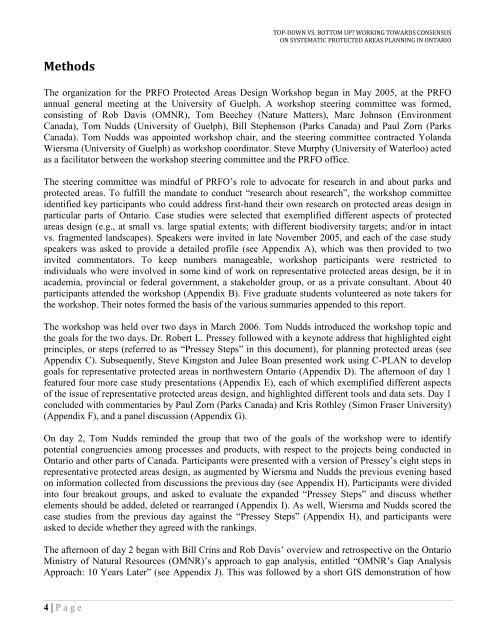Top-Down vs. Bottom Up: Working Towards Consensus ... - CASIOPA
Top-Down vs. Bottom Up: Working Towards Consensus ... - CASIOPA
Top-Down vs. Bottom Up: Working Towards Consensus ... - CASIOPA
- No tags were found...
Create successful ePaper yourself
Turn your PDF publications into a flip-book with our unique Google optimized e-Paper software.
TOP-DOWN VS. BOTTOM UP? WORKING TOWARDS CONSENSUSON SYSTEMATIC PROTECTED AREAS PLANNING IN ONTARIOMethodsThe organization for the PRFO Protected Areas Design Workshop began in May 2005, at the PRFOannual general meeting at the University of Guelph. A workshop steering committee was formed,consisting of Rob Davis (OMNR), Tom Beechey (Nature Matters), Marc Johnson (EnvironmentCanada), Tom Nudds (University of Guelph), Bill Stephenson (Parks Canada) and Paul Zorn (ParksCanada). Tom Nudds was appointed workshop chair, and the steering committee contracted YolandaWiersma (University of Guelph) as workshop coordinator. Steve Murphy (University of Waterloo) actedas a facilitator between the workshop steering committee and the PRFO office.The steering committee was mindful of PRFO‟s role to advocate for research in and about parks andprotected areas. To fulfill the mandate to conduct “research about research”, the workshop committeeidentified key participants who could address first-hand their own research on protected areas design inparticular parts of Ontario. Case studies were selected that exemplified different aspects of protectedareas design (e.g., at small <strong>vs</strong>. large spatial extents; with different biodiversity targets; and/or in intact<strong>vs</strong>. fragmented landscapes). Speakers were invited in late November 2005, and each of the case studyspeakers was asked to provide a detailed profile (see Appendix A), which was then provided to twoinvited commentators. To keep numbers manageable, workshop participants were restricted toindividuals who were involved in some kind of work on representative protected areas design, be it inacademia, provincial or federal government, a stakeholder group, or as a private consultant. About 40participants attended the workshop (Appendix B). Five graduate students volunteered as note takers forthe workshop. Their notes formed the basis of the various summaries appended to this report.The workshop was held over two days in March 2006. Tom Nudds introduced the workshop topic andthe goals for the two days. Dr. Robert L. Pressey followed with a keynote address that highlighted eightprinciples, or steps (referred to as “Pressey Steps” in this document), for planning protected areas (seeAppendix C). Subsequently, Steve Kingston and Julee Boan presented work using C-PLAN to developgoals for representative protected areas in northwestern Ontario (Appendix D). The afternoon of day 1featured four more case study presentations (Appendix E), each of which exemplified different aspectsof the issue of representative protected areas design, and highlighted different tools and data sets. Day 1concluded with commentaries by Paul Zorn (Parks Canada) and Kris Rothley (Simon Fraser University)(Appendix F), and a panel discussion (Appendix G).On day 2, Tom Nudds reminded the group that two of the goals of the workshop were to identifypotential congruencies among processes and products, with respect to the projects being conducted inOntario and other parts of Canada. Participants were presented with a version of Pressey‟s eight steps inrepresentative protected areas design, as augmented by Wiersma and Nudds the previous evening basedon information collected from discussions the previous day (see Appendix H). Participants were dividedinto four breakout groups, and asked to evaluate the expanded “Pressey Steps” and discuss whetherelements should be added, deleted or rearranged (Appendix I). As well, Wiersma and Nudds scored thecase studies from the previous day against the “Pressey Steps” (Appendix H), and participants wereasked to decide whether they agreed with the rankings.The afternoon of day 2 began with Bill Crins and Rob Davis‟ overview and retrospective on the OntarioMinistry of Natural Resources (OMNR)‟s approach to gap analysis, entitled “OMNR‟s Gap AnalysisApproach: 10 Years Later” (see Appendix J). This was followed by a short GIS demonstration of how4 | P a g e


